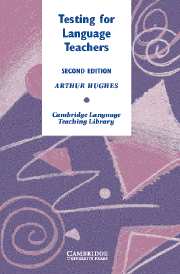Book contents
- Frontmatter
- Contents
- Acknowledgements
- Preface
- 1 Teaching and testing
- 2 Testing as problem solving: an overview of the book
- 3 Kinds of tests and testing
- 4 Validity
- 5 Reliability
- 6 Achieving beneficial backwash
- 7 Stages of test development
- 8 Common test techniques
- 9 Testing writing
- 10 Testing oral ability
- 11 Testing reading
- 12 Testing listening
- 13 Testing grammar and vocabulary
- 14 Testing overall ability
- 15 Tests for young learners
- 16 Test administration
- Appendix 1 The statistical analysis of test data
- Appendix 2 Item banking
- Appendix 3 Questions on the New Zealand youth hostels passage
- Bibliography
- Subject Index
- Author Index
8 - Common test techniques
Published online by Cambridge University Press: 05 May 2010
- Frontmatter
- Contents
- Acknowledgements
- Preface
- 1 Teaching and testing
- 2 Testing as problem solving: an overview of the book
- 3 Kinds of tests and testing
- 4 Validity
- 5 Reliability
- 6 Achieving beneficial backwash
- 7 Stages of test development
- 8 Common test techniques
- 9 Testing writing
- 10 Testing oral ability
- 11 Testing reading
- 12 Testing listening
- 13 Testing grammar and vocabulary
- 14 Testing overall ability
- 15 Tests for young learners
- 16 Test administration
- Appendix 1 The statistical analysis of test data
- Appendix 2 Item banking
- Appendix 3 Questions on the New Zealand youth hostels passage
- Bibliography
- Subject Index
- Author Index
Summary
What are test techniques?
Quite simply test techniques are means of eliciting behaviour from candidates that will tell us about their language abilities. What we need are techniques that:
will elicit behaviour which is a reliable and valid indicator of the ability in which we are interested;
will elicit behaviour which can be reliably scored;
are as economical of time and effort as possible;
will have a beneficial backwash effect, where this is relevant.
From Chapter 9 to Chapter 13, techniques are discussed in relation to particular abilities. Techniques that may be thought to test ‘overall ability’ are treated in Chapter 14. The present chapter introduces common techniques that can be used to test a variety of abilities, including reading, listening, grammar and vocabulary. This is to avoid having to introduce them repeatedly in the chapters in which they appear later. We begin with an examination of the multiple choice technique and then go on to look at techniques that require the test taker to construct a response (rather than just select one from a number provided by the test maker).
Multiple choice items
Multiple choice items take many forms, but their basic structure is as follows.
There is a stem:
Enid has been here half an hour.
and a number of options – one of which is correct, the others being distractors:
A. during B. for C. while D. since
It is the candidate's task to identify the correct or most appropriate option (in this case B).
Information
- Type
- Chapter
- Information
- Testing for Language Teachers , pp. 75 - 82Publisher: Cambridge University PressPrint publication year: 2002
